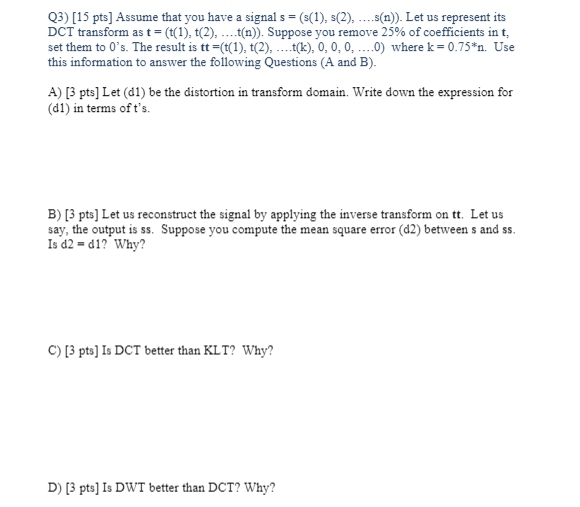Question
Q3) [15 pts] Assume that you have a signal s = (s(1), s(2), ..s(n)). Let us represent its DCT transform as t = (t(1),

Q3) [15 pts] Assume that you have a signal s = (s(1), s(2), ..s(n)). Let us represent its DCT transform as t = (t(1), t(2), ...(n)). Suppose you remove 25% of coefficients in t, set them to 0's. The result is tt =(t(1), t(2), (k), 0, 0, 0, ...0) where k = 0.75*n. Use this information to answer the following Questions (A and B). %3D A) [3 pts] Let (d1) be the distortion in transform domain. Write down the expression for (d1) in terms of t's. B) [3 pts] Let us reconstruct the signal by applying the inverse transform on tt. Let us say, the output is ss. Suppose you compute the mean square error (d2) between s and ss. Is d2 = d1? Why? C) [3 pts] Is DCT better than KLT? Why? D) [3 pts] Is DWT better than DCT? Why?
Step by Step Solution
There are 3 Steps involved in it
Step: 1
DCTI...
Get Instant Access to Expert-Tailored Solutions
See step-by-step solutions with expert insights and AI powered tools for academic success
Step: 2

Step: 3

Ace Your Homework with AI
Get the answers you need in no time with our AI-driven, step-by-step assistance
Get StartedRecommended Textbook for
Contemporary Auditing
Authors: Michael C. Knapp
8th edition
978-0538466790, 538466790, 978-1285066608
Students also viewed these Accounting questions
Question
Answered: 1 week ago
Question
Answered: 1 week ago
Question
Answered: 1 week ago
Question
Answered: 1 week ago
Question
Answered: 1 week ago
Question
Answered: 1 week ago
Question
Answered: 1 week ago
Question
Answered: 1 week ago
Question
Answered: 1 week ago
Question
Answered: 1 week ago
Question
Answered: 1 week ago
Question
Answered: 1 week ago
Question
Answered: 1 week ago
Question
Answered: 1 week ago
Question
Answered: 1 week ago
Question
Answered: 1 week ago
Question
Answered: 1 week ago
Question
Answered: 1 week ago
Question
Answered: 1 week ago
Question
Answered: 1 week ago
Question
Answered: 1 week ago
Question
Answered: 1 week ago
Question
Answered: 1 week ago
View Answer in SolutionInn App



